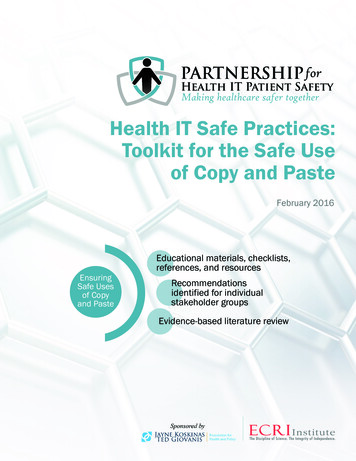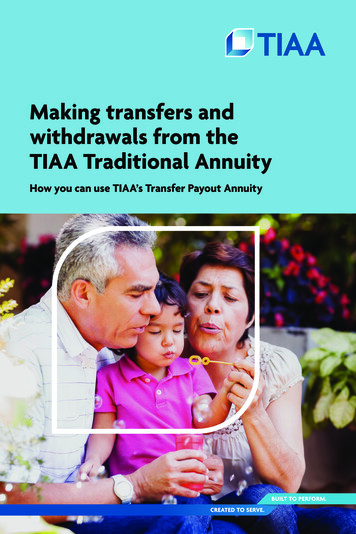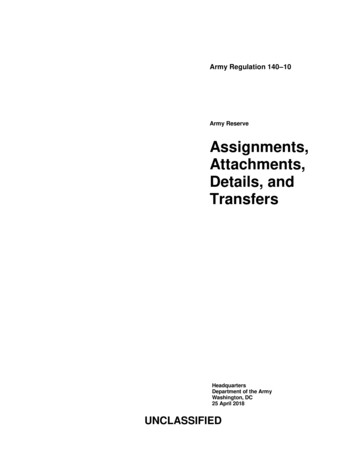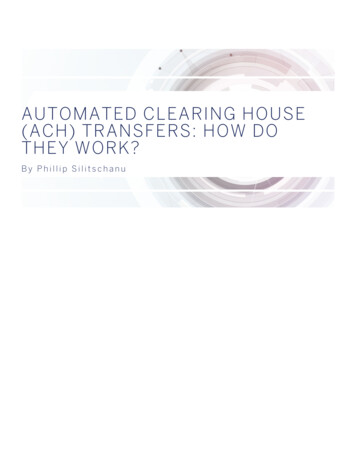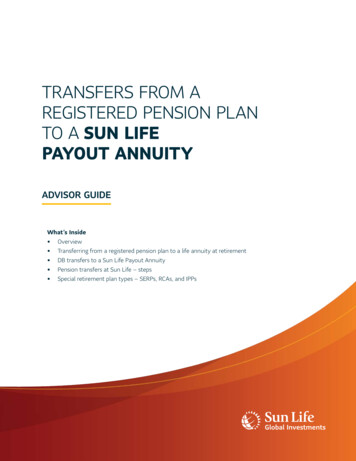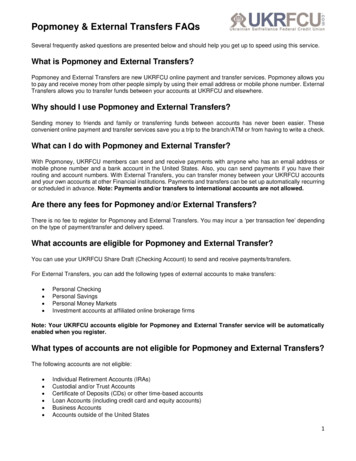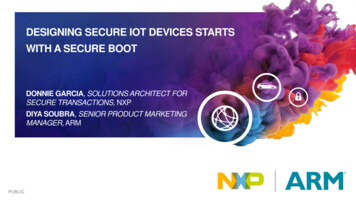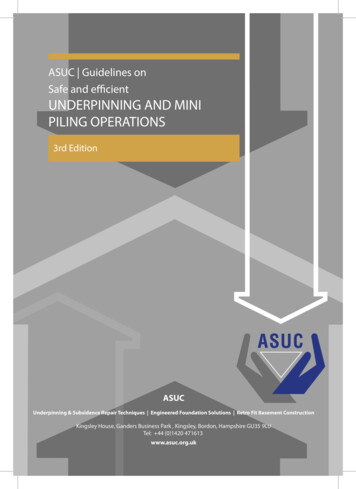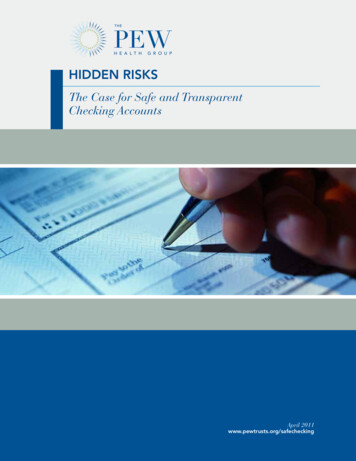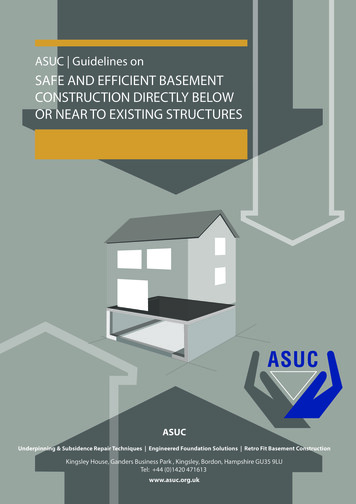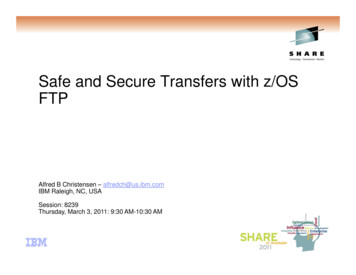
Transcription
Safe and Secure Transfers with z/OSFTPAlfred B Christensen – alfredch@us.ibm.comIBM Raleigh, NC, USASession: 8239Thursday, March 3, 2011: 9:30 AM-10:30 AM
Safe and Secure Transfers with z/OS FTPSession number:8239Date and time:Thursday, March 3, 2011: 9:30 AM-10:30 AMLocation:Room 212B (Anaheim Convention Center)Program:Communications InfrastructureProject:Communications ServerTrack:Network Support and Management, Security Administration and Security and Privacy d B Christensen, IBMAbstract:FTP is a readily available, convenient, and inexpensive technology to transfers files and datasets between z/OS and a virtually unlimited number of other operating system platforms. FTPis not a bad technology, as some recent press might lead you to believe. FTP can be misusedand cause problems if the FTP service isn't properly set up to prevent potential securityexposures. This session will explore a wide range of aspects related to how FTP works onz/OS. The session will reveal 'hidden gems' of FTP on z/OS and will look at a set of usagescenarios, providing suggestions on how to best exploit selected features of the z/OS FTPtechnology. The session will especially focus on how you can secure both the FTP environmentitself and the individual data transfers that z/OS FTP participates in both as a client and as aserver.Page 2 2011 SHARE and IBM Corporation
Trademarks, notices, and disclaimersThe following terms are trademarks or registered trademarks of International Business Machines Corporation in the United States or other countries or both: Advanced Peer-to-PeerNetworking AIX alphaWorks AnyNet AS/400 BladeCenter Candle CICS DataPower DB2 Connect DB2 DRDA e-business on demand e-business (logo) e business(logo) ESCON FICON GDDM GDPS Geographically DispersedParallel Sysplex HiperSockets HPR Channel Connectivity HyperSwap i5/OS (logo) i5/OS IBM eServer IBM (logo) IBM IBM zEnterprise System IMS InfiniBand IP PrintWay IPDS iSeries LANDP Language Environment MQSeries MVSNetView OMEGAMON Open PowerOpenPowerOperating System/2 Operating System/400 OS/2 OS/390 OS/400 Parallel Sysplex POWER POWER7 PowerVMPR/SMpSeries RACF Rational Suite Rational RedbooksRedbooks (logo)Sysplex Timer System i5System p5System x System z System z9 System z10Tivoli (logo) Tivoli VTAM WebSphere xSeries z9 z10 BCz10 EC zEnterprisezSeries z/Architecturez/OS z/VM z/VSE* All other products may betrademarks or registeredtrademarks of theirrespective companies.The following terms are trademarks or registered trademarks of International Business Machines Corporation in the United States or other countries or both: Adobe, the Adobe logo, PostScript, and the PostScript logo are either registered trademarks or trademarks of Adobe Systems Incorporated in the United States, and/or other countries. Cell Broadband Engine is a trademark of Sony Computer Entertainment, Inc. in the United States, other countries, or both and is used under license there from. Java and all Java-based trademarks are trademarks of Sun Microsystems, Inc. in the United States, other countries, or both. Microsoft, Windows, Windows NT, and the Windows logo are trademarks of Microsoft Corporation in the United States, other countries, or both. InfiniBand is a trademark and service mark of the InfiniBand Trade Association. Intel, Intel logo, Intel Inside, Intel Inside logo, Intel Centrino, Intel Centrino logo, Celeron, Intel Xeon, Intel SpeedStep, Itanium, and Pentium are trademarks or registered trademarks of IntelCorporation or its subsidiaries in the United States and other countries. UNIX is a registered trademark of The Open Group in the United States and other countries. Linux is a registered trademark of Linus Torvalds in the United States, other countries, or both. ITIL is a registered trademark, and a registered community trademark of the Office of Government Commerce, and is registered in the U.S. Patent and Trademark Office. IT Infrastructure Library is a registered trademark of the Central Computer and Telecommunications Agency, which is now part of the Office of Government Commerce.Notes: Performance is in Internal Throughput Rate (ITR) ratio based on measurements and projections using standard IBM benchmarks in a controlled environment. The actual throughput that anyuser will experience will vary depending upon considerations such as the amount of multiprogramming in the user's job stream, the I/O configuration, the storage configuration, and the workloadprocessed. Therefore, no assurance can be given that an individual user will achieve throughput improvements equivalent to the performance ratios stated here. IBM hardware products are manufactured from new parts, or new and serviceable used parts. Regardless, our warranty terms apply. All customer examples cited or described in this presentation are presented as illustrations of the manner in which some customers have used IBM products and the results they may haveachieved. Actual environmental costs and performance characteristics will vary depending on individual customer configurations and conditions. This publication was produced in the United States. IBM may not offer the products, services or features discussed in this document in other countries, and the information may be subject tochange without notice. Consult your local IBM business contact for information on the product or services available in your area. All statements regarding IBM's future direction and intent are subject to change or withdrawal without notice, and represent goals and objectives only. Information about non-IBM products is obtained from the manufacturers of those products or their published announcements. IBM has not tested those products and cannot confirm theperformance, compatibility, or any other claims related to non-IBM products. Questions on the capabilities of non-IBM products should be addressed to the suppliers of those products. Prices subject to change without notice. Contact your IBM representative or Business Partner for the most current pricing in your geography.Refer to www.ibm.com/legal/us for further legal information.Page 3 2011 SHARE and IBM Corporation
Agenda FTP and Security – an oxymoron? SSL/TLS FTP: Keys and certificates overview z/OS FTP Server with server authentication only– client WS FTP Pro on Windows z/OS FTP Server with server authentication andclient authentication – client WS FTP Pro onWindows z/OS FTP client connecting to a FileZillaWindows server with server authentication only Appendix A: z/OS FTP – local security Appendix B: Secure FTP - network traversalchallenges and solutionsDisclaimer: All statements regarding IBM future direction or intent, including current product plans, are subject to change orwithdrawal without notice and represent goals and objectives only. All information is provided for informational purposes only,on an “as is” basis, without warranty of any kind.Page 4 2011 SHARE and IBM Corporation
Safe and Secure Transfers with z/OS FTPFTP and Security – an oxymoron?Page 5 2011 SHARE and IBM Corporation
Let's try and clear a little common confusion from the startRFC959FTP FTP:– Also referred to as RFC959 FTP or “normal” FTP– The FTP protocol we all know and have used for years.– The FTP protocol has been extended numerous times since the original RFC959 was issued in 1985 Specific support for both Kerberos-based and SSL/TLS-based securityhas been added to the FTP protocol RFC4217 "Securing FTP with TLS"– What the z/OS CS FTP client and server have supported through many years An RFC959 FTP client talks to an RFC959 FTP server, and not to an sftpserverSecure sftp:Shell– Secure Shell file transfer protocolFTP A sub-protocol of SSH (Secure Shell) Supported on z/OS by "IBM Ported tools for z/OS" and at least two ISVproducts Has nothing to do with RFC959 FTP - incompatible protocols An sftp client talks to an sftp server and not an RFC959 FTP serverRFC4217 FTPS:FTP– Also referred to as RFC4217 FTP, FTP AUTH-TLS, or FTP AUTH-SSL– Secure RFC959 FTP using a standard security mechanism, such asKerberos or SSL/TLS RFC4217 "Securing FTP with TLS"– The normal FTP protocol but extended with full network security(authentication, data integrity, and data privacy)– Both control connection and data connection can be secured No user IDs or password flowing in the clear 2011 SHARE and IBM CorporationPage 6
A quick comparison of selected z/OS file transfer technologies from a securityperspectiveFTPFTPSFTPSFTPWith no securityFTP w. SSL/TLSFTP w. IPSecAs implemented byIBM Ported ToolsRFC959 RFC4217Any RFC levelRFC959User ID and password protectionNoYesYesYesData protection (the file beingtransferred)NoYesYesYesz/OS UNIX file supportYesYesYesYesz/OS MVS data set supportYesYesYesNo (but add-onproducts do exist)Use of System z hardware encryptiontechnologiesn/aYesYesYes (for randomnumber generation)Partner authentication via locally storedcopies of public keysn/aNoYes (pre-sharedkey)YesPartner authentication via X509certificatesn/aYesYesNoUse of SAF key rings and/or ICSFn/aYesYesYesFIPS 140-2 moden/aYes (z/OSV1R11)NoNoMutual authentication supportedn/aYesYes (at an IPaddress level)YesMVS data set support example: Dovetailed Technologies’ Co:Z SFTPPage 7 2011 SHARE and IBM Corporation
FTP Server CPU usage with and without securityFTP CPU Usage250Microsec CPU200128 connectionsClear Text150AT-TLSIPSec without zIIPs10032 connectionszIIP processor“pegged”IPSec with zIIPs500050100150M B/Se cAll measurements done with z/OS V1R11Outbound Data (Gets) to an MVS client3DES encryption with SHA authenticationFrom 1 to 128 parallel connectionsHighest throughput numbers obtained with 0 think-time200250300Client: 1 z10 LPAR (3 dedicated CPs)Server: 1 z10 LPAR (4 dedicated CPs)Connectivity: OSA-E3 10 GbEEncryption/Authentication: 3DES/SHATransaction: 1 byte / 2 MBTarget data sets: MVS data sets on 3390 DASDThink time: 1500 msNumber of connections: 1 to 128Driver tool: AWMAll performance data contained in this publication was obtained in the specific operating environment and under the conditions described and is presented as anillustration. Performance obtained in other operating environments may vary and customers should conduct their own testing.Page 8 2011 SHARE and IBM Corporation
Safe and Secure Transfers with z/OS FTPSSL/TLS FTP:Keys and certificates overviewNote: This will hurt your brain, but this is where you all run intoproblems when trying to set up SSL/TLS for the first time!Page 9 2011 SHARE and IBM Corporation
SSL/TLS application typesPort-determined SSL/TLS (Implicit)connectSSL/TLS handshakeSecure connectionServer port xAll connectionsto port x will besecure As soon as a connection has beenestablished with the server, theSSL/TLS handshake starts Examples are the HTTPS port (443),and FTP’s secure port (990) AT-TLS considerations:– Can be done totally transparent toapplication code This is referred to as an AT-TLS"Basic" application– Optionally the application may querySSL/TLS attributes, such as clientuser ID (if client authentication isused, cipher suite in use, etc) This is referred to as an AT-TLS"Aware" applicationPage 10Application-negotiated SSL/TLS (Explicit)connectNon-secure negotiationSSL/TLS handshakeSecure connectionServer port yConnect to port y,and then negotiate ifconnection shouldbe secured or not Application protocol includes verbs tonegotiate security protocol and options Examples are FTP that uses the AUTH FTPcommand to negotiate use of SSL/TLS orKerberos, and in some cases a TN3270server port (Conntype NegtSecure) AT-TLS considerations:– Application needs to "tell" AT-TLS when tostart the SSL/TLS handshake This is referred to as an AT-TLS"Controlling" application– Otherwise, use of AT-TLS is transparent toapplication– Optionally the application may querySSL/TLS attributes, such as client user ID(if client authentication is used, cipher suitein use, etc) 2011 SHARE and IBM Corporation
Cryptographic Basics Cryptography is the use of mathematical algorithms to transform data for the purposes ofensuring:– Partner authentication – proving the other end point of the secure communication iswho it claims to be (certificates and asymmetric encryption)– Data privacy – hiding the data (encryption/decryption)– Data integrity – proving the data hasn’t been modified since it was sent (messagedigests and secure message authentication codes)– Data origin authentication – proving the data’s origin (message digests and securemessage authentication codes) Cryptographic operations are compute intensive, hence the need for hardware assisttechnologies General rule: For a given algorithm: the longer keys,the stronger security, the more compute intensive– For example, AES-128 vs. AES-256– Increases the amount of work anattacker needs to do to crack the codeEncryptionstrength, CPUcost, time toencrypt/decryptKey lengthPage 11 2011 SHARE and IBM Corporation
Symmetric encryptionDES, 3DES, AES, .Cleartext:“MVS isgreat!”Ciphertext:*7 &hl;f9jjut8(DES, 3DES, AES, .Cleartext:“MVS isgreat!”Exact same value Only one key value - “shared secret” between both parties– Used for both encryption and decryption– Hence, the symmetry; each side has the same key and use the samealgorithm Much faster than asymmetric cryptography– You typically use symmetric encryption for bulk encryption/decryption Also known as – “secret key encryption” Securely sharing and exchanging the key between both parties is a major issuePage 12 2011 SHARE and IBM Corporation
Asymmetric encryptionRSA, DSA, .Cleartext:Cleartext:*7 &hl;f9jjut8(“MVS isgreat!”Private keyRSA, DSA, .Ciphertext:“MVS isgreat!”Mathematically linked,but not the same valuePublic key Two different key values – no shared secrets!– Private key is known only to owner and is kept under lock!– Public key is freely distributed to others– Data encrypted with private key can only bedecrypted with public key and vice versaPrivatekey– No way to derive one key value from the otherPublickey Great for authentication and non-repudiation– “digital signatures” - signing with private key Very expensive computationally– Not so great for bulk encryption - usually used to encrypt small data objects likemessage digests or symmetric keys Also known as “public key cryptography”Page 13RSA: Rivest, Shamir and AdlemanDSA: Digital Signature AlgorithmPublickey 2011 SHARE and IBM Corporation
Digital signatureCleartext:Cleartext:“MVS isgreat!”SHA-1, SHA-2, MD5, .“MVS isgreat!”SHA-1, SHA-2, MD5, .SignatureSignatureRSA, DSA, .RSA, DSA, .digestDo thesetwo match?digestDecrypted SignaturePrivate keyMathematically linked, butnot the same valuePublic key A digital signature is a message digest that has been encrypted with the sender’s private key. If the receiver recalculates the message digest, decrypts the signature with the sender’s publickey, and compares the decrypted signature to the recalculated message digest – the twoshould match:– The message text cannot have been modified since the signature was calculated– The signature cannot have been tampered with– The signature could only have been created by the partner with the matching private keySHA: Secure Hash Algorithm – MDn: Message Digest nPage 14 2011 SHARE and IBM Corporation
Trust relationships via Certificate Authorities – getting my public keydistributed to those who need it1My corporation: ABCABCPrivatekey5ABC Certificate Request1. Generate a key-pair: A private key A matching public key2. Generate a certificaterequest document and(e)mail to a CertificateAuthority Name andaddress of myABC corporation My web URI . ABC public key2ABC CertificateABCPublickey4 Name and address ofmy ABC corporation My web URI . ABC public keyABCCertificate Signed by the CA’sprivate key6CACertificateinstalledas atrustedroot (a CA)Page 15User AliceCACertificate1. Verify validity of ABC’s certificate bydecrypting signature using CA’s public keyand compare to content of the certificate If they match, the certificate was indeedissued by our trusted CA2. Because ABC trusted the CA, and Alice truststhe CA, Alice can now trust ABCCertificate AuthorityCAPrivatekeyCAPublickey3 1. Validate requestand requestor2. Generate ABCcertificate –signed with theCA’s private key3. Send ABC’scertificate back toABC 2011 SHARE and IBM Corporation
SSL/TLS use of hardware crypto functionsCrypto TypeAsymmetricencrypt / decryptSymmetricencrypt / decryptSymmetricauthenticationPage 16AlgorithmCPACF available onlyCPACF plus Coprocessor / AcceleratoravailableRSA signature generationIn softwareIn coprocessor mode only. Otherwise in software(Accelerator does not support this option)RSA signature verificationIn softwareIn coprocessor / acceleratorPKA encrypt / decrypt for handshakeIn softwareIn coprocessor / acceleratorDES encrypt / decryptCPACF (non-FIPS mode only; DES not allowed in FIPS mode)3DES encrypt / decryptCPACFAES-CBC-128 encrypt / decryptCPACFAES-CBC-256 encrypt / decryptIn software on z9, in CPACF on z10SHA-1 digest generationCPACFSHA-224 digest generationCPACFSHA-256 digest generationCPACFSHA-384 digest generationIn software on z9, in CPACF on z10SHA-512 digest generationIn software on z9, in CPACF on z10MD5In software (non-FIPS mode only; MD5 not allowed in FIPS mode) 2011 SHARE and IBM Corporation
Hardware support With AT-TLS enabled, check the TCP/IP stack SYSOUT file for details on whichcryptographic algorithms are supported by your mSystemSystemSystemPage 17SSL:SSL:SSL:SSL:SSL:SSL:SSL:SSL:SSL:SSL:SHA-1 crypto assist is availableSHA-224 crypto assist is availableSHA-256 crypto assist is availableSHA-384 crypto assist is availableSHA-512 crypto assist is availableDES crypto assist is availableDES3 crypto assist is availableAES 128-bit crypto assist is availableAES 256-bit crypto assist is availableICSF services are not available 2011 SHARE and IBM Corporation
Safe and Secure Transfers with z/OS FTPz/OS FTP Server with serverauthentication only – client WS FTPPro on WindowsWS FTP Professional is a product from Ipswitch File Transfer Division:http://www.ipswitchft.com/products/ws ftp pro/index.aspxThis material does not in any way endorse or promote WS FTP Professional, but merely uses it as an example of a WindowsFTP client that supports SSL/TLS FTP functions.Page 18 2011 SHARE and IBM Corporation
What is needed for z/OS Server authentication only (which issufficient for encrypted data exchange)CA certificate w.CA public keyCA certificate w.CA public keyKey-ring of the serverstarted task user IDClientkey-ringSigned bythe CAprivate keyServerkey-ringServer certificate w.server public keyServerprivate keyTCP connection setupWindows FTP Clientz/OS FTP ServerHello – I want to use SSL/TLS1. Verify server certificatehas not expired2. Verify server certificateis valid using CA'spublic key3. Do optional checks onthe server certificate4. Store server's public keyfor later use5. Generate symmetric keyand encrypt underserver's public keyPage 19Hello – OK, me too !!And here is my server certificate CA may be an external CA, such as Verisign, or it maybe an in-house CA In both cases, the CA root certificate needs to bepresent at both the client and the server side The server certificate is signed by the CA and is storedon the server side On z/OS, this will typically be the default certificate inthe server's started task user ID's key-ring in RACF During SSL handshake, the server certificate (not theserver private key) is sent to the client The client verifies the certificates signature using theCA public key in its copy of the CA certificateServer certificate w.server public keyHere is our secret symmetric keyEncrypted under your public key 2011 SHARE and IBM Co
– What the z/OS CS FTP client and server have supported through many years An RFC959 FTP client talks to an RFC959 FTP server, and not to an sftp server sftp: – Secure Shell file transfer protocol A sub-protocol of SSH (Secure Shell)
